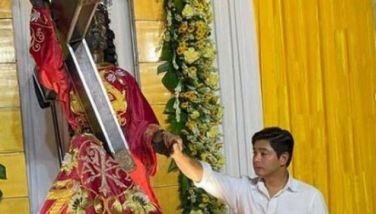When history repeats itself
As we mark Bonifacio Day today, we remember the Great Plebeian’s bravery, heroism and love of country.
Of course, Andres Bonifacio remains runner-up to Jose Rizal as the national hero. However, there had been several debates in the past to make Bonifacio take over Rizal’s title. Don’t look now, but in time, Ninoy Aquino may just crowd them in and Bonifacio may even be relegated to third place.
Filipinos are actually not really all that remiss anymore when it comes to honoring Bonifacio. How many major thoroughfares are there all over the country called A. Bonifacio? Aside from the Monumento at the north end of EDSA that is dedicated in his honor, some schoolyards also have Bonifacio statues.
Local filmmakers and TV directors, too have also dramatized his life story and usually cast actors with brown skin in his role: Robert Arevalo, Gardo Verzosa, among them. But was he really brown-skinned? His mother, Catalina de Castro, was a Spanish mestiza, after all.
The missing pieces of information about his life make it difficult to put together an Andres Bonifacio movie. We commemorate Rizal Day on Dec. 30 because that was when he was executed in Bagumbayan in 1896. That was put on record since it was a public execution witnessed by so many people.
Bonifacio Day rites, however, are carried out on Nov. 30 yearly, his birthday, because did he really die on May 10, 1897 in the mountains of Maragondon in Cavite in the hands of Emilio Aguinaldo’s men as claimed by some books? Historians should be thankful enough that there were records of his birth.
Was he a lowly native or was born to an ilustrado family? Maybe they started out rich, except that his parents died when he was 14 and he had to stop schooling and feed his younger siblings by selling fans and canes.
The latest Bonifacio film, Ang Paglilitis kay Andres Bonifacio, doesn’t bother with his early life. There was even no mention that he first married a woman named Monica, who shortly after died of leprosy. An entry to the 2010 Cinemalaya, it casts Alfred Vargas as Bonifacio and it dwells, as the title puts it, on the hero’s trial after that infamous Tejeros convention that started it all: Aguinaldo was elected President of the Republic of the Philippines, while Bonifacio was made Secretary of the Interior with some tactless delegate later questioning the latter’s capacity to hold such a position, prompting the supreme head of the Katipunan to form his own government.
Directed by Mario O’Hara, the movie brings in witness after witness to speak on behalf or against Bonifacio. The process becomes tedious after a while and with all the unknown actors being interrogated by an overacting panel, that part of the film begins to look like a casting call for O’Hara’s next full-length picture. It becomes so tiring to watch that the viewer is tempted to lead another uprising this time against the creative team of this movie project.
In one scene, there is an attempt to break the monotony of the overly stretched trial by putting a slight comedic touch: An effeminate helper is mistaken for a witness when he’s actually there to ask what the panelists want for snacks. They order boiled sweet potatoes. Couldn’t the writer have been more imaginative? Was camote the only merienda served in those days? Nothing fancier than that? I guess that’s in keeping with the boring scenario.
Oh, I would have forgiven the tediousness of this film had they gone to the extreme end with the 1897 characters sending out for Jollibee. If the purpose of those repetitive scenes was to show the absurdity of the trial, then swing to the really inane for greater impact.
Truthfully, I would have gladly taken in a simple, but well-researched depiction of the events in Bonifacio’s life and minus that bald female narrator painted in white.
Ang Paglilitis has its merits though. It starts with a colorful komedya that is staged in a very engaging manner. The photography is brilliant what with the sepia tones that make the viewer feels like he is in a time machine that goes back to the late 19th century.
2008 Binibining Pilipinas-World Danielle Castaño in her first acting stint is also impressive as Bonifacio’s wife, Gregoria de Jesus. Her face is very cinematic. It’s actually a blank canvass that she later fills with emotions as a desperate wife in search of her husband.
Alfred, unfortunately, wasn’t utilized that much. The character Bonifacio he plays in the movie may not have begged for his life, but Vargas the actor begs to be given more. He makes up for that in the execution scene where he is remarkable. I also commend O’Hara for that entire sequence. It is a very effective dramatization of what may have occurred during Bonifacio’s last hours on earth.
At the end of the film, the viewer is again driven to the conclusion that nothing ever changes in the Philippines:
1) Nobody loses in an election. The one who doesn’t get the numbers is cheated.
2) We will never be one as a nation. There is always divisiveness like the Magdiwang and Magdalo factions among the Katipuneros more than a century ago.
3) Most local film bios are always laborious lessons in history. You know why people don’t watch these movies.
I now appreciate more than ever the Biography channel on cable.
- Latest
- Trending

































